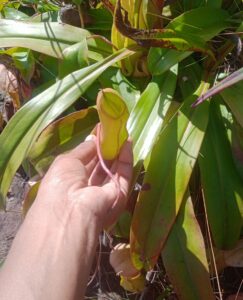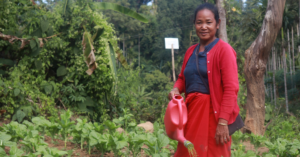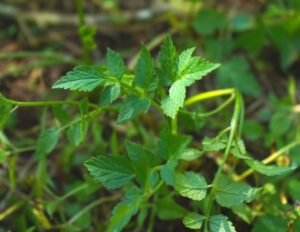The Pitcher Plant, with its unique shape and carnivorous nature, has been a source of intrigue and inspiration in many folk stories. Cultures from across Asia and Africa have revered the pitcher plant as a symbol of hope and optimism. However, in the Western cultures, it is looked upon as a plant of deceit and bad luck. In other cultures, it is also looked upon as the guardian of secrets.
The Pitcher Plant also known as Ein Pharei (Khasi-Jaintia language) locally is carnivorous in nature as it eats insects and small animals. It is one of the oldest plants found naturally in the hills of the Mustem village, West Jaintia Hills. The plant is also found in the nearby villages of Chyrmang and Iongnoh. It chooses the steep valleys and the mountain side as its natural habitat because it prefers to grow independently in spacious places aloof from the trees. The climatic conditions of Mustem is heavy rainfall with thick fog whereas during the winter it is very dry.
The team of NESFAS, while conversing with the locals tried to dissect the origin of the pitcher plant on who brought the plant to the area or whether it was cultivated on purpose. “It seemed as if the plant chose the area on its own because of the landscape and the terrain.” They added that what makes the pitcher plant unique in comparison to all the other plants is that it has a funnel-like structure where it stores water. The people of Mustem and the nearby villages have often taken their liking to drink from the pitcher plant as the water from it is quite refreshing. However, the community members warned the team not to drink from it if the lip closing the funnel is opened, as the water is no longer safe to drink. The water accumulates more during the summers and less during winters.
They also added that through the years, they found the pitcher plant to be medicinal and have since then started cultivating it. The village Dorbar has put forward an initiative to plant the pitcher plant in a designated location by shifting it from other locations and has also prohibited anyone from destroying it making it mandatory for its protection. Diseases like Urinary tract infection, abdominal pain, and digestive problems, particularly constipation are treated using the water from the pitcher plant. In other places, an extract from the plant is also used for treatment of smallpox and prevention of scar formation.
Nature has blessed the Khasi Hills with myriad medicinal herbs. We have only realised their importance in recent years. Through the TNC-funded project “Protection of forests in Meghalaya by adopting participatory, gender centric and equitable approaches” that focuses on the People’s Biodversity Registers, NESFAS has stretched its wings for the protection of the rich bio-diverse haven in the hills with many more tales to uncover.




